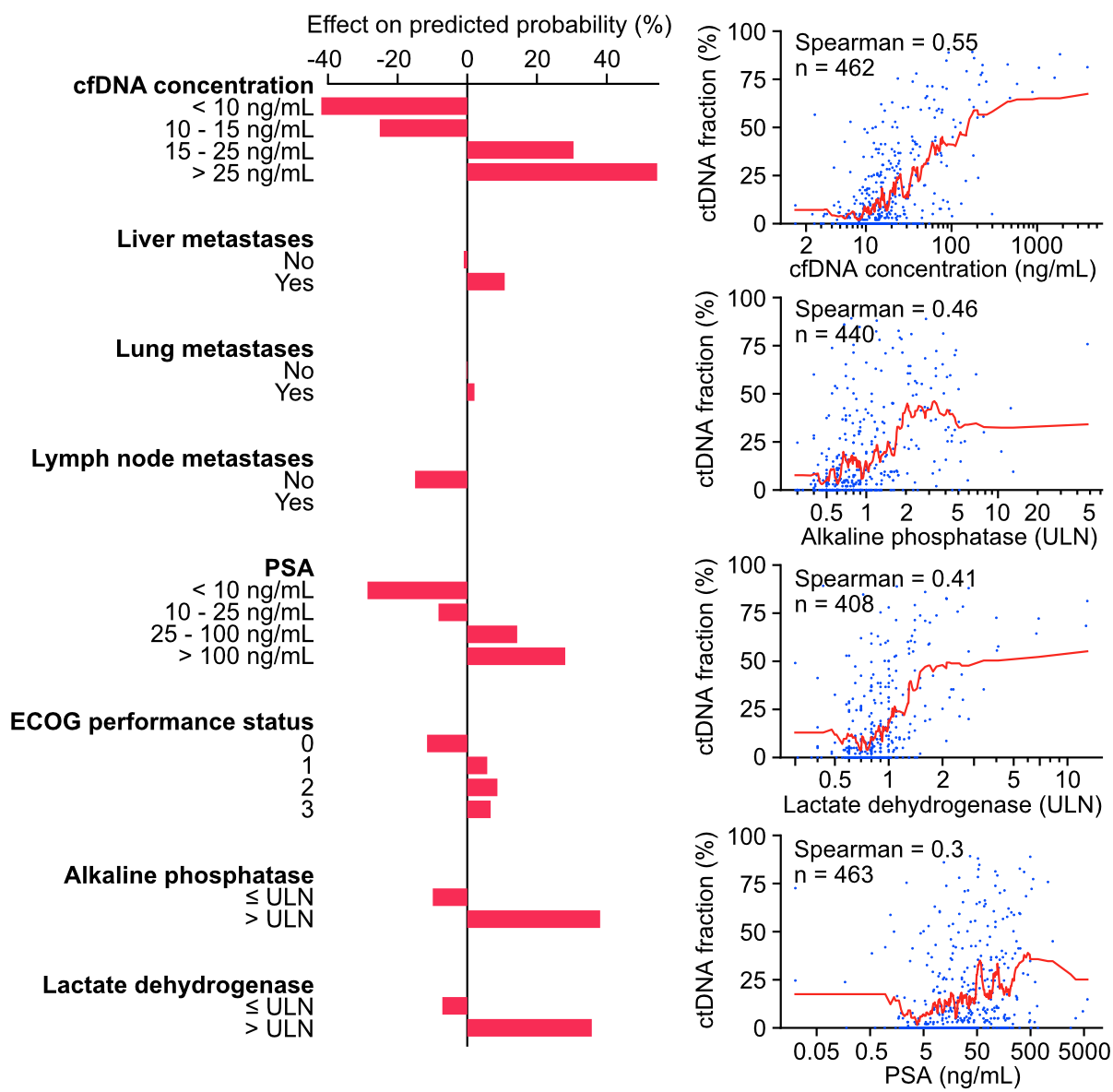How to use this website
Fill in a patient's clinical information and press the button labeled "Predict ctDNA%". All fields are optional but the more you provide the more accurate the results will be. The website predicts the patient's plasma circulating tumor DNA (ctDNA) fraction, as well as the probability of the patient having a ctDNA fraction greater than 2%.
What is this website useful for?
Commercial ctDNA tests are now widely used to identify patients for biomarker-directed therapies (e.g. PARP inhibitors in BRCA2-defective cancers), but these tests are uninformative if the plasma ctDNA fraction is too low. We have developed this research tool to help users decide whether to pursue ctDNA- or tissue-based biomarker testing, by predicting a patient’s ctDNA fraction based on routinely collected clinical information.

What is circulating tumor DNA?
All humans carry short circulating DNA fragments, known as cell-free DNA (cfDNA), in their blood. These DNA fragments originate from dying cells in the body. In patients with cancer, a significant fraction of the cell-free DNA in blood can originate from tumor cells. These tumor-derived DNA fragments are known as circulating tumor DNA (ctDNA). By analyzing the circulating tumor DNA present in a patient's blood, clinicians and oncologists can characterize the DNA alterations that drive a patient's cancer.
Are the results applicable to all prostate cancer patients?
Predicted ctDNA fractions are valid for metastatic castration-resistant prostate cancer patients with clinically progressing disease. This means patients that are not receiving systemic therapy or whose cancer is progressing despite ongoing treatment. Blood samples obtained during effective treatment typically contain significantly lower ctDNA fractions, so this tool is not appropriate for predicting ctDNA fraction in on-treatment samples.
What is ctDNA fraction?
The amount of circulating tumor DNA in a patient's bloodstream depends on the number of cancer cells in their body. It is often quantified as the percentage of circulating tumor DNA, relative to total cell-free DNA in the sample. This percentage is referred to as the circulating tumor DNA fraction (ctDNA fraction, ctDNA%). If the circulating tumor DNA fraction is very low, it may be impossible to detect cancer driving mutations in the blood sample, and a more costly tissue biopsy may be required instead.
How do you predict ctDNA fraction?
Predictions are based on a gradient boosting model trained using 738 plasma cell-free DNA samples from metastatic castration-resistant prostate cancer patients accrued to our liquid biopsy collection program in Vancouver, Canada.
Which clinical factors are the most predictive?
Plasma cell-free DNA concentration, lactate dehydrogenase, alkaline phosphatase, and PSA are most strongly correlated with ctDNA fraction. The figure below shows the effect of different clinical variables on the predicted probability of a plasma sample's ctDNA fraction being greater than 2%.

Who created this website?
This website is the product of a collaboration between the Wyatt Lab at the Vancouver Prostate Centre (Canada) and the Computational Biology Group at Tampere University (Finland). Methods development and data analysis was performed by Matti Annala, Wilson Tu, Cameron Herberts, Nicolette Fonseca, and Sinja Taavitsainen. Clinical data was collected by Daniel Khalaf, Corinne Maurice-Dror, and Edmond Kwan. A manuscript about the ctDNA fraction prediction methodology has been published in Nature Communications (2024).
Any inquiries about the website or data should be sent by email to Matti Annala or Alexander Wyatt.
Disclaimer
This prediction tool (website) is intended for research use only. The website is not to be used as a substitute for medical advice, diagnosis, or treatment of any health condition or problem. The authors make no warranties, nor express or implied representations whatsoever, regarding the accuracy, completeness, timeliness, or usefulness of any information contained or referenced on this website. The authors do not assume any risk whatsoever for your use of the prediction tools or the information contained herein. Health related information changes frequently and therefore information contained in the prediction tools may be outdated, incomplete or incorrect.